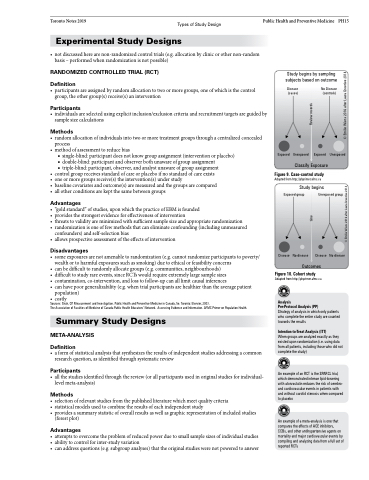Page 1233 - TNFlipTest
P. 1233
Toronto Notes 2019 Types of Study Design Public Health and Preventive Medicine PH15 Experimental Study Designs
• notdiscussedherearenon-randomizedcontroltrials(e.g.allocationbyclinicorothernon-random basis – performed when randomization is not possible)
RANDOMIZED CONTROLLED TRIAL (RCT)
Definition
• participantsareassignedbyrandomallocationtotwoormoregroups,oneofwhichisthecontrol group, the other group(s) receive(s) an intervention
Participants
• individualsareselectedusingexplicitinclusion/exclusioncriteriaandrecruitmenttargetsareguidedby sample size calculations
Methods
• randomallocationofindividualsintotwoormoretreatmentgroupsthroughacentralizedconcealed process
• methodofassessmenttoreducebias
■ single-blind: participant does not know group assignment (intervention or placebo) ■ double-blind: participant and observer both unaware of group assignment
■ triple-blind: participant, observer, and analyst unaware of group assignment
• controlgroupreceivesstandardofcareorplaceboifnostandardofcareexists
• oneormoregroupsreceive(s)theintervention(s)understudy
• baselinecovariatesandoutcome(s)aremeasuredandthegroupsarecompared
• allotherconditionsarekeptthesamebetweengroups
Advantages
• “goldstandard”ofstudies,uponwhichthepracticeofEBMisfounded
• providesthestrongestevidenceforeffectivenessofintervention
• threatstovalidityareminimizedwithsufficientsamplesizeandappropriaterandomization
• randomizationisoneoffewmethodsthatcaneliminateconfounding(includingunmeasured
confounders) and self-selection bias
• allowsprospectiveassessmentoftheeffectsofintervention
Disadvantages
• someexposuresarenotamenabletorandomization(e.g.cannotrandomizeparticipantstopoverty/ wealth or to harmful exposures such as smoking) due to ethical or feasibility concerns
• canbedifficulttorandomlyallocategroups(e.g.communities,neighbourhoods)
• difficulttostudyrareevents,sinceRCTswouldrequireextremelylargesamplesizes
• contamination,co-intervention,andlosstofollow-upcanalllimitcausalinferences
• canhavepoorgeneralizability(e.g.whentrialparticipantsarehealthierthantheaveragepatient
population)
• costly
Sources: Shah, CP. Measurement and Investigation. Public Health and Preventive Medicine in Canada, 5e. Toronto: Elsevier, 2003. TheAssociationofFacultiesofMedicineofCanadaPublicHealthEducators’Network. AssessingEvidenceandInformation.AFMCPrimeronPopulationHealth.
Summary Study Designs
META-ANALYSIS
Definition
• aformofstatisticalanalysisthatsynthesizestheresultsofindependentstudiesaddressingacommon research question, as identified through systematic review
Participants
• allthestudiesidentifiedthroughthereview(orallparticipantsusedinoriginalstudiesforindividual- level meta-analysis)
Methods
• selectionofrelevantstudiesfromthepublishedliteraturewhichmeetqualitycriteria
• statisticalmodelsusedtocombinetheresultsofeachindependentstudy
• providesasummarystatisticofoverallresultsaswellasgraphicrepresentationofincludedstudies
(forest plot)
Advantages
• attemptstoovercometheproblemofreducedpowerduetosmallsamplesizesofindividualstudies • abilitytocontrolforinter-studyvariation
• canaddressquestions(e.g.subgroupanalyses)thattheoriginalstudieswerenotpoweredtoanswer
Study begins by sampling subjects based on outcome
Disease No Disease (cases) (controls)
Exposed Unexposed Exposed Unexposed Classify Exposure
Figure9.Case-controlstudy
Adapted from http://phprimer.afmc.ca Study begins
Exposed group
Unexposed group
Disease
No disease Outcomes
No disease
Figure 10. Cohort study
Adapted from http://phprimer.afmc.ca
Disease
Analysis
Per-Protocol Analysis (PP)
Strategy of analysis in which only patients who complete the entire study are counted towards the results
Intention-to-Treat Analysis (ITT)
When groups are analyzed exactly as they existed upon randomization (i.e. using data from all patients, including those who did not complete the study)
An example of an RCT is the SPARCL trial, which demonstrated intense lipid-lowering with atorvastatin reduces the risk of cerebro- and cardiovascular events in patients with and without carotid stenosis when compared to placebo
An example of a meta-analysis is one that compares the effects of ACE inhibitors, CCBs, and other antihypertensive agents on mortality and major cardiovascular events by compiling and analyzing data from a full set of reported RCTs
time Review records
© Emilie Wiens 2016 after Laura Greenlee 2014
© Emilie Wiens 2016 after Laura Greenlee 2014


